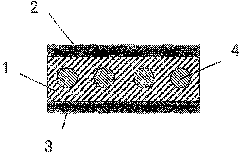Organic semiconductor element and organic electrode
A technology of organic semiconductors and components, applied in semiconductor devices, semiconductor/solid-state device manufacturing, electrical components, etc.
- Summary
- Abstract
- Description
- Claims
- Application Information
AI Technical Summary
Problems solved by technology
Method used
Image
Examples
specific example
[0064] Specific examples of derivatives used in the present invention are as follows:
[0065]
[0066] These tetrathiafulvalene derivatives can be used independently or in combination according to conventional practice. These derivatives can be synthesized by synthetic methods known in the art. Also, those synthesized using the synthesis method proposed by the present inventors can be used (see Japanese Patent Application No. 2009-073990, No. 2010-000319 and No. 2010-026729, the disclosures of which are incorporated herein by reference).
[0067] For example, tetrathiafulvalene derivatives can be produced by subjecting 1,3-bisthiol-2-one compounds, which are raw materials, to a coupling reaction (see J. Org, Chem., 2000, 65, 5794-5805). In this case, the raw material 1,3-bisthiol-2-one compound can be obtained, for example, in the following manner. By the reactions disclosed in J.Org.Chem.1994,59,6519-6527, Chem.Commun.1998,361-362, Chem.Commun.1998,2197-2198, Tetrahedro...
Embodiment 1
[0088] Prepared using bis(anthracene[2,3-d])tetrathiafulvalene (1) as follows Figure 1D An organic semiconductor element with an upper contact structure is shown.
[0089] An n-type silicon substrate provided with a thermally oxidized film having a thickness of 300 nm was washed by immersing the substrate in strong sulfuric acid for 24 hours. The washed silicon substrate was immersed in a toluene solution of a silane coupling agent (ie, octyltrichlorosilane) (1 mM), and subjected to ultrasonic treatment for 5 minutes to form a monomolecular film on the surface of the silicon oxide film.
[0090] On the substrate prepared above by vacuum evaporation (back pressure: up to 10 -4 Pa, deposition rate: , film thickness: 25 nm) bis(anthracene[2,3-d])tetrathiafulvalene (1) was deposited on the entire surface of the substrate to form a film, thereby forming a first organic compound layer. Thereafter, fullerenes were deposited by evaporation using a metal mask having an electrode...
Embodiment 2
[0097] The electrical characteristics of the organic semiconductor element prepared in Example 1 were evaluated in the same manner as in Example 1, except that the probing positions of the source and drain electrodes were changed to Figure 2B The probing position shown in 2. As a result, it was found that the organic semiconductor element exhibits the characteristics of a p-type organic thin film transistor. The current-voltage (I-V) characteristics of the organic thin film transistor are in Figure 4 shown in .
[0098] The electron field effect mobility of the organic thin film transistor is 0.005cm 2 / Vs.
PUM
 Login to View More
Login to View More Abstract
Description
Claims
Application Information
 Login to View More
Login to View More - R&D
- Intellectual Property
- Life Sciences
- Materials
- Tech Scout
- Unparalleled Data Quality
- Higher Quality Content
- 60% Fewer Hallucinations
Browse by: Latest US Patents, China's latest patents, Technical Efficacy Thesaurus, Application Domain, Technology Topic, Popular Technical Reports.
© 2025 PatSnap. All rights reserved.Legal|Privacy policy|Modern Slavery Act Transparency Statement|Sitemap|About US| Contact US: help@patsnap.com



